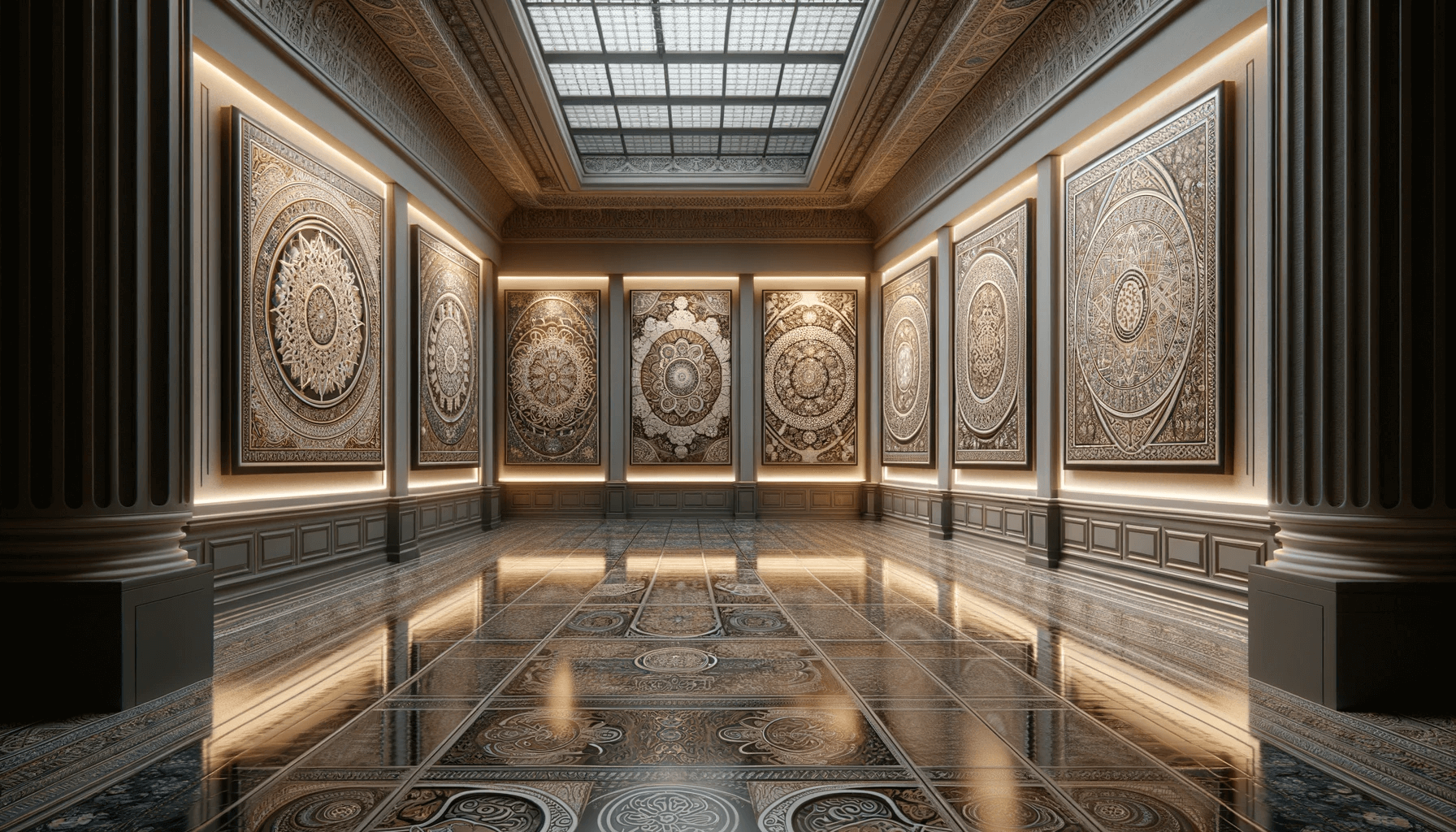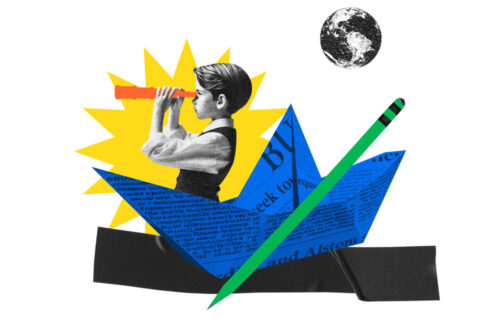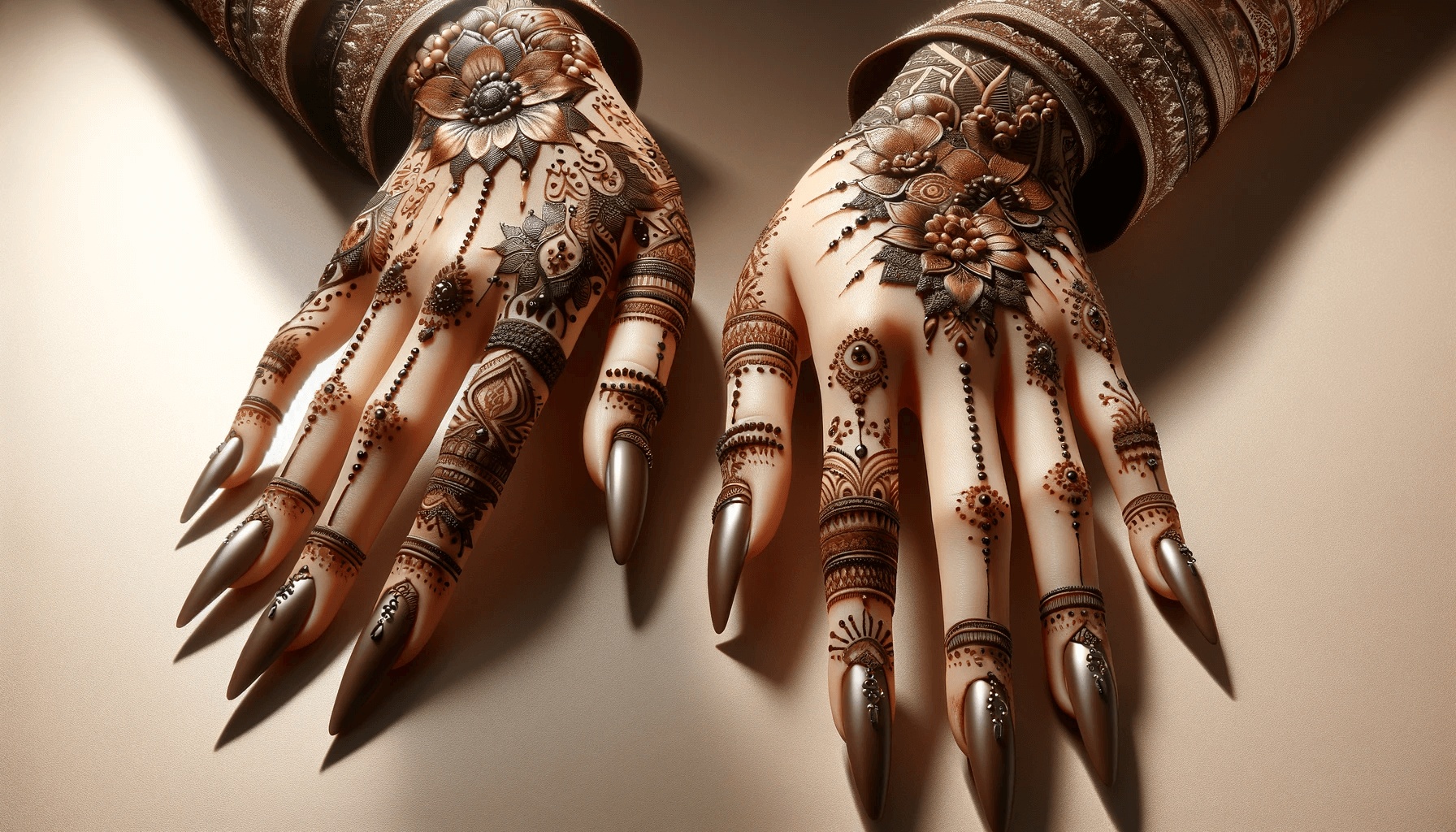Repetition in Art, which we often also call “rhythm in art” are motives that repeat themselves and create a pattern.
Are you ready to dive into the mesmerizing world of repetition in art?
From ancient cave paintings to contemporary masterpieces, repetition has been a powerful tool used by artists to evoke emotions, create visual impact, and convey a sense of rhythm.

In this article, we will explore the principles of design and how they relate to the repetition and rhythm in art.
Firstly, let’s get a better understanding of repetition in art. From patterns to shapes, colors, and textures, repetition can be found in various forms in artwork. But it is not just about repeating the same element over and over again. Repetition can also involve variations that add depth and complexity to the artwork, making it more captivating.
Moreover, repetition is closely related to the principle of rhythm in art. Rhythm refers to the movement and flow created by the repetition of elements in a composition. It can be regular, irregular, or alternating and can have a significant impact on how the viewer perceives the artwork.
Throughout this article, we will explore the fascinating relationship between repetition and rhythm in art, the different types of rhythmic patterns, and the role of patterns in artistic creations. Moreover, we will provide you with practical techniques to incorporate repetition into your own artwork, and learn how to balance unity and variety to create a compelling composition. Get ready to unleash your creativity through repetition and rhythm!
Understanding Repetition in Art
So you want to understand the ins and outs of repetition in art, huh? You’re in for a treat! Repetition, as a concept, is all about the power of repeating a visual element in an artwork. It can be anything from a shape, a color, a line, or even a texture, and it’s used to create a sense of harmony and unity within the piece.
Repetition is a staple in various forms of art, and it’s intriguing to see how artists use it to their advantage. It’s almost like a secret weapon that can add a punch to the artistic composition.
When repetition is used effectively, it can reinforce the message of the artwork and create a memorable experience for the viewer. It’s like a catchy tune that sticks in your head, but with visual elements that engage your senses.
The Intricacies of Repetition in Art
Repetition in art is not just about copying and pasting the same element repeatedly. It’s important to understand the variations and nuances that make it interesting. Here are some examples:
| Type of Repetition | Description | Example |
|---|---|---|
| Exact Repetition | The same visual element is repeated identically. | A row of identical circles. |
| Gradual Repetition | The visual element is repeated with slight variations in size, color, or shape. | A series of circles increasing in size. |
| Alternative Repetition | Two or more elements are repeated in a fixed pattern. | A checkerboard pattern of alternating black and white squares. |
As you can see, repetition goes beyond just creating copies of the same element. It’s about creating a sense of movement and rhythm that elevates the artwork and creates an immersive experience.
Now that you have a good grasp of what repetition in art entails, it’s time to explore how artists take advantage of it. In the next section, we’ll dive deeper into the rhythmic aspect of repetition and explore the principle of rhythm.
Unleashing the Power of Rhythm Principle in Art
Get ready to groove to the beat of the rhythm principle in art! This principle is all about creating a flow and movement in your artwork using repetition. By creating a pattern that repeats itself, you can create a sense of unity and harmony, guiding the viewer’s eyes throughout your creation.
To understand the rhythm principle better, think about music. Most songs have a beat that repeats itself, creating a pattern that makes us want to dance or tap our feet. Similarly, in art, a repeated pattern creates a visual rhythm that captures our attention and guides us along the artwork.
There are several types of rhythmic patterns that artists can use, including:
| Type of Pattern | Description |
|---|---|
| Regular | A pattern with equal spacing between each element, creating a predictable rhythm. |
| Irregular | A pattern with varying spacing between each element, creating a more unpredictable rhythm. |
| Flowing | A pattern that mimics the movement of water or wind, creating a sense of fluidity. |
By utilizing these different types of patterns, artists can create a variety of visual rhythms to evoke different emotions and moods.
The rhythm principle not only creates visual interest but also supports the overall composition of an artwork. It can be used to create a focal point, balance the elements, and unify the piece. Without rhythm, an artwork can feel chaotic or static.
So go ahead and play with repetition to create a sense of rhythm in your artwork. Don’t be afraid to experiment with different patterns, and try to find the perfect rhythm that suits your artistic style.
Exploring Patterns in Art
Patterns in art can be mesmerizing, intriguing, and even hypnotic. But where do they come from? You guessed it – repetition and rhythm! Let’s dive deeper into the world of patterns in art and discover how repetition and rhythm play a crucial role.
Patterns can be found in various art styles and genres, from ancient tapestries to contemporary graphic design. They rely heavily on repetition and a sense of rhythm, which can create a visual harmony that engages the viewer’s eye.
- Geometric Patterns
Geometric patterns utilize shapes to create repetitive structures. Triangles, circles, squares, and rectangles can be combined in endless possibilities to create intricate designs. This type of pattern is prevalent in Islamic art, where it is used to represent the unending nature of God.
- Organic Patterns
Organic patterns are inspired by natural forms, such as leaves, flowers, and waves. They often have a flowing, organic feel that evokes a sense of movement and growth. This type of pattern can be found in Art Nouveau and other styles that celebrate the beauty of nature.
- Stripes and Checks
Stripes and checks are simple patterns that rely on repetition of a basic unit. Horizontal or vertical stripes and checkered patterns can create a striking effect, especially when used in contrasting colors. This type of pattern is often associated with fashion and textiles.
Patterns can also be used to create contrast and visual interest in an artwork. A repeated motif can be interrupted by a variation or a change in color to create a focal point or to add tension.
Whether you prefer geometric or organic, subtle or bold, patterns are a fascinating aspect of art that are worth exploring. And remember, it all starts with the principles of repetition and rhythm!
Enhancing Creativity through Repetition and Variation
Are you looking to take your artistic practice to the next level? Look no further than the power of repetition and variation. By using repetitive elements as a foundation for experimentation, you can unlock your full creative potential and produce captivating artworks.
Repetition is not only a powerful tool for creating visual impact, but it also promotes a sense of harmony and unity in your compositions. By establishing a rhythmic pattern through repetition, you can guide the viewer’s eye through your artwork and create a more immersive experience.
However, don’t fall into the trap of monotony. Variation is just as crucial for maintaining interest and impact in your artwork. By introducing subtle changes to the repetitive elements, you can keep your viewer engaged and intrigued.
| Repetition in Art | Repetition and Rhythm |
|---|---|
| Repetition is the use of the same element multiple times in an artwork. | Rhythm is a principle of design that utilizes repetition to create a sense of movement or flow in an artwork. |
| Repetition can be used to create patterns, emphasize certain elements, and convey a sense of unity. | Rhythmic patterns can be created through repeated use of elements such as lines, shapes, or colors, and contribute to the overall composition of an artwork. |
| Repetition can be used across various art forms such as painting, sculpture, and graphic design. | Rhythm can be used to establish a pace or mood within an artwork, and has different types such as regular, alternating, and progressive. |
So, how can you effectively utilize repetition and variation in your own artwork? Consider implementing techniques such as the use of line, shape, color, and texture to establish patterns and create a sense of rhythm.
- Experiment with different types of rhythmic patterns, such as regular, alternating, or progressive.
- Introduce subtle variations to the repetitive elements, such as changing the color or size of an element.
- Explore different art styles and genres to gain inspiration for incorporating repetition and variation.
Remember, the key to successful repetition and variation in art is finding the right balance between unity and variety. By breaking repetitive patterns strategically, you can create visual tension and maintain the viewer’s interest.
Get creative and start experimenting with repetition and variation in your artwork today. Who knows, you may just surprise yourself with what you create!
Examples of Repetition in Famous Artworks
You’ve learned about the power of repetition in art, but let’s look at some specific examples of how artists have utilized this concept to create stunning works. These masterpieces showcase the artistic skill of the creators and prove that repetition is a technique that can stand the test of time.
Andy Warhol’s Campbell’s Soup Cans
When you think of repetition in art, it’s hard not to think of Andy Warhol’s iconic Campbell’s Soup Cans. Warhol created multiple pieces, each featuring a single can of Campbell’s Soup, but with different flavors. By repeating the same image with small variations, Warhol created a series that was both visually compelling and thought-provoking. The repetition of the soup cans also serves as a commentary on mass production and consumer culture.
Gustav Klimt’s The Tree of Life
Gustav Klimt’s The Tree of Life is a beautiful example of how repetition can be used to create intricate patterns and designs. The painting features a golden tree with branches that twist and turn, creating a decorative and rhythmic pattern. Klimt repeats the same shapes and motifs throughout the painting, resulting in a harmonious and visually stunning work of art.
Yayoi Kusama’s Infinity Mirrored Room
Yayoi Kusama’s Infinity Mirrored Room is a mesmerizing installation that features multiple reflective surfaces and tiny lights. The repetition of the mirrors and the lights creates a sense of infinity and gives the viewer a feeling of being lost in space. By repeating the same elements over and over, Kusama creates an immersive and otherworldly experience.
Vincent van Gogh’s The Starry Night
Vincent van Gogh’s The Starry Night is a masterpiece that uses repetition to create a sense of movement and emotion. The painting features swirling stars and a moon that repeats across the canvas. The repetition of these elements gives the painting a sense of rhythm and energy, making it feel like the sky is in motion. The repetition also creates a dreamlike quality, adding to the painting’s emotional impact.
These are just a few examples of how repetition can be used in art to create stunning and memorable works. By utilizing the power of repetition, artists can create visual interest, convey emotions, and push the boundaries of their craft.
Techniques for Implementing Repetition in Your Art
So, you want to incorporate repetition in your artwork? That’s great news! Repetition is a powerful tool that can take your creations to the next level. But where do you start? Here are some useful techniques to get you going:
1. Line and Shape
One of the simplest and most common ways to use repetition is through line and shape. By repeating a particular line or shape, you can create a pattern that generates a sense of rhythm and harmony. Try experimenting with different shapes and thicknesses of lines to find the perfect combination that best expresses your artistic vision.
2. Color
Repetition of color is another great technique for creating a cohesive and visually appealing artwork. You can use different shades of the same color or a combination of complementary colors to establish patterns that draw the viewer’s eye. Don’t be afraid to play with colors and find a color palette that fits your style and theme.
3. Texture
Texture repetition is a wonderful way to add depth and interest to your artwork. By repeating a particular texture, you can create a tactile quality that adds a dynamic element to your composition. Experiment with different textures, such as rough, smooth, and shiny, to see what works best.
4. Scale
Varying the size of repeated elements can add a whole new dimension to your artwork. By playing with scale, you can create a sense of movement and dynamism that draws the viewer’s eye. Try experimenting with different scales to see what effects you can achieve.
5. Negative Space
Don’t forget the power of negative space when it comes to repetition. By leaving intentional empty spaces, you can create a pattern that draws attention to the areas where repetition occurs. This technique can be especially effective when combined with other methods of repetition, such as line and shape.
With these techniques in mind, you can start experimenting with repetition in your art. Remember, repetition is just the foundation – variation is what keeps things interesting. So, don’t be afraid to add some twists and surprises to your repeating elements to keep your artwork fresh and captivating.
Breaking the Repetition: Balancing Unity and Variety
Congratulations! You’ve mastered the art of repetition in your artwork. But wait, there’s more! Just like a jazz musician who knows how to riff off a tune, you too can break the repetition and create a masterpiece that balances both unity and variety.
Breaking the Mold
When it comes to repetition in art, breaking the mold can be just as important as creating it. Just like how a song that repeats the same melody can grow tedious after a while, a piece of art with an unchanging visual rhythm can feel monotonous.
So how do you break the repetition? By introducing elements of variety. This can take the form of a change in color, texture, or shape. You could also experiment with different scales, introduce negative space or throw in an unexpected detail that catches the viewer’s eye. By doing so, you create visual tension that keeps your audience engaged and interested.
Unity vs. Variety
While it’s crucial to break the repetition, it’s equally important to maintain a sense of unity within your artwork. Too much variation can lead to disarray and confusion, leaving the viewer unsure about where to focus their attention.
So how do you balance unity and variety? It’s all about finding a happy medium. Start by establishing a pattern or rhythm within your work, using repetition to create a sense of unity. Then, gradually introduce variations that complement the overall composition without detracting from it. Think of it as a dance between order and chaos.
Experimentation and Innovation
Remember, experimentation and innovation are key to enhancing your artwork. Don’t be afraid to try new things and push the boundaries of repetition. Think outside the box, break the rules and take risks. Who knows? You may just discover a new form of visual expression that sets your artwork apart from the rest.
So go forth, artist, and break the repetition. Balance unity and variety, experiment and innovate. The world of repetition in art is your playground.




